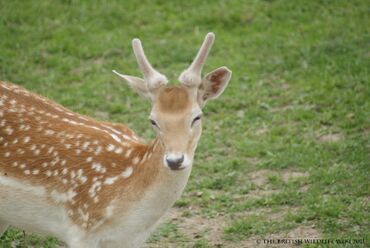
Fallow Deer - WWC Archives
The Fallow Deer (Dama dama) is a ruminant mammal belonging to the family Cervidae.
The male is known as a buck, the female is a doe, and the young a fawn. Adult bucks are 140–160 cm long and 90–100 cm shoulder height, and 60–85 kg in weight; does are 130–150 cm long and 75–85 cm shoulder height, and 30–50 kg in weight. Fawns are born in spring at about 30 cm and weigh around 4.5 kg. The life span is around 12–16 years. All of the Fallow deer have white spots on their backs, and black tips at the ends of their tails.
The species has great variations in the colour of their coats, with four main variants, "common", "menil", "melanistic" and "white" - a genuine colour variety, not albinistic. The common coat variation has a brown coat with white mottles that are most pronounced in summer with a much darker coat in the winter. The white is the lightest colored, almost white; common and menil are darker, and melanistic is very dark, sometimes even black (easily confused with the Sika Deer). Most herds consist of the common coat variation, yet it is not rare to see animals of the menil, melanistic and white coat variations as well.
Only bucks have antlers, which are broad and shovel-shaped. They are grazing animals; their preferred habitat is mixed woodland and open grassland. During the rut bucks will spread out and females move between them, at this time of year fallow deer are relatively ungrouped compared to the rest of the year when they try to stay together in groups of up to 150.
Distribution and history[]
The Fallow Deer is a Eurasian deer that was a native to most of Europe during the last Interglacial. In the Holocene, the distribution was restricted to the Middle East and possibly also parts of the Mediterranean region, while further southeast in western Asia was the home of a close relative, the Persian Fallow Deer (Dama mesopotamica), that is bigger and has larger antlers. In the Levant, Fallow Deer were an important source of meat in the Palaeolithic Kebaran-culture (17000-10000 BC), as is shown by animal bones from sites in northern Israel, but the numbers decreased in the following epi-Palaeolithic Natufian culture (10000-8500 BC), perhaps because of increased aridity and the decrease of wooded areas.
Britain[]
The Fallow Deer was spread across central Europe by the Romans. Until recently it was thought that the Normans introduced them to Great Britain and to Ireland for hunting in the royal forests. However recent finds at Fishbourne Roman Palace show that Fallow Deer were introduced into southern England in the 1st century AD. It is not known whether these escaped to form a feral colony, or whether they died out and were reintroduced by the Normans.
Fallow deer are now widespread on the UK mainland and are present in most of England and Wales below a line drawn from the Wash to the Mersey. There have been long standing populations in the New Forest and the Forest of Dean and many of the other populations originated from park escapees. They are not quite so widespread in the northern parts of England but are present in most lowland areas and also in parts of Scotland, principally in the Tay valley and around Loch Lomond. According to the British Deer Society distribution survey 2007 they have enjoyed an increase in range since the previous survey in 2000 although the increase in range is not as spectacular as for some of the other deer species.
A significant number of the fallow in the Forest of Dean and in Epping Forest are of the black variety. One particularly interesting population is that based in the Mortimer Forest on the England/Wales border where a significant part of the population have long hair with distinct ear tufts and longer body hair.
The Fallow Deer is easily tamed and is often kept semi-domesticated in parks today.
Gallery[]
Videos[]

British Wildlife Clips - Fallow Deer




